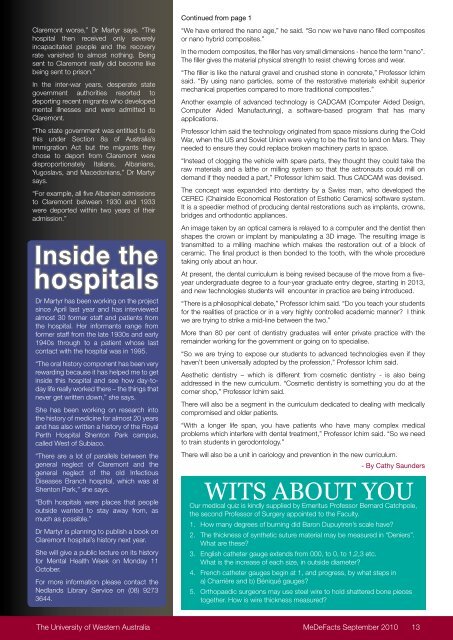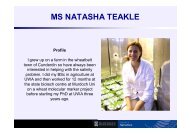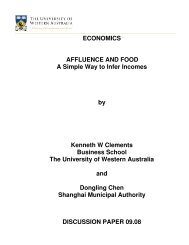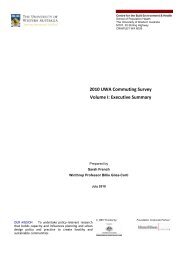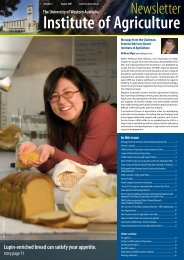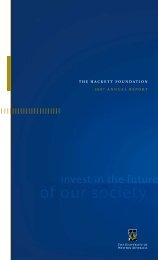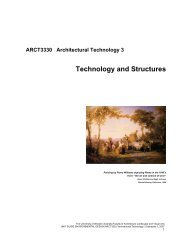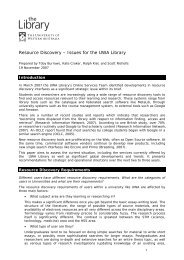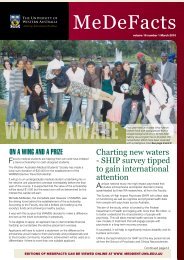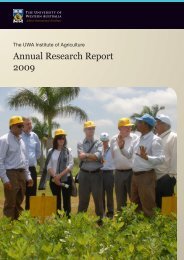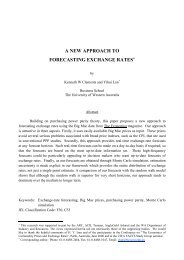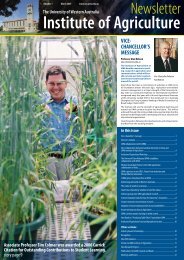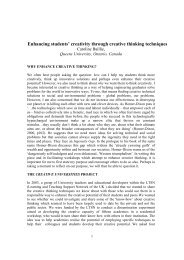MeDeFacts September 2010 - The University of Western Australia
MeDeFacts September 2010 - The University of Western Australia
MeDeFacts September 2010 - The University of Western Australia
You also want an ePaper? Increase the reach of your titles
YUMPU automatically turns print PDFs into web optimized ePapers that Google loves.
Claremont worse,” Dr Martyr says. “<strong>The</strong><br />
hospital then received only severely<br />
incapacitated people and the recovery<br />
rate vanished to almost nothing. Being<br />
sent to Claremont really did become like<br />
being sent to prison.”<br />
In the inter-war years, desperate state<br />
government authorities resorted to<br />
deporting recent migrants who developed<br />
mental illnesses and were admitted to<br />
Claremont.<br />
“<strong>The</strong> state government was entitled to do<br />
this under Section 8a <strong>of</strong> <strong>Australia</strong>’s<br />
Immigration Act but the migrants they<br />
chose to deport from Claremont were<br />
disproportionately Italians, Albanians,<br />
Yugoslavs, and Macedonians,” Dr Martyr<br />
says.<br />
“For example, all five Albanian admissions<br />
to Claremont between 1930 and 1933<br />
were deported within two years <strong>of</strong> their<br />
admission.”<br />
inside the<br />
hospitals<br />
Dr Martyr has been working on the project<br />
since April last year and has interviewed<br />
almost 30 former staff and patients from<br />
the hospital. Her informants range from<br />
former staff from the late 1930s and early<br />
1940s through to a patient whose last<br />
contact with the hospital was in 1995.<br />
“<strong>The</strong> oral history component has been very<br />
rewarding because it has helped me to get<br />
inside this hospital and see how day-today<br />
life really worked there – the things that<br />
never get written down,” she says.<br />
She has been working on research into<br />
the history <strong>of</strong> medicine for almost 20 years<br />
and has also written a history <strong>of</strong> the Royal<br />
Perth Hospital Shenton Park campus,<br />
called West <strong>of</strong> Subiaco.<br />
“<strong>The</strong>re are a lot <strong>of</strong> parallels between the<br />
general neglect <strong>of</strong> Claremont and the<br />
general neglect <strong>of</strong> the old Infectious<br />
Diseases Branch hospital, which was at<br />
Shenton Park,” she says.<br />
“Both hospitals were places that people<br />
outside wanted to stay away from, as<br />
much as possible.”<br />
Dr Martyr is planning to publish a book on<br />
Claremont hospital’s history next year.<br />
She will give a public lecture on its history<br />
for Mental Health Week on Monday 11<br />
October.<br />
For more information please contact the<br />
Nedlands Library Service on (08) 9273<br />
3644.<br />
Continued from page 1<br />
“We have entered the nano age,” he said. “So now we have nano filled composites<br />
or nano hybrid composites.”<br />
In the modern composites, the filler has very small dimensions - hence the term “nano”.<br />
<strong>The</strong> filler gives the material physical strength to resist chewing forces and wear.<br />
“<strong>The</strong> filler is like the natural gravel and crushed stone in concrete,” Pr<strong>of</strong>essor Ichim<br />
said. “By using nano particles, some <strong>of</strong> the restorative materials exhibit superior<br />
mechanical properties compared to more traditional composites.”<br />
Another example <strong>of</strong> advanced technology is CADCAM (Computer Aided Design,<br />
Computer Aided Manufacturing), a s<strong>of</strong>tware-based program that has many<br />
applications.<br />
Pr<strong>of</strong>essor Ichim said the technology originated from space missions during the Cold<br />
War, when the US and Soviet Union were vying to be the first to land on Mars. <strong>The</strong>y<br />
needed to ensure they could replace broken machinery parts in space.<br />
“Instead <strong>of</strong> clogging the vehicle with spare parts, they thought they could take the<br />
raw materials and a lathe or milling system so that the astronauts could mill on<br />
demand if they needed a part,” Pr<strong>of</strong>essor Ichim said. Thus CADCAM was devised.<br />
<strong>The</strong> concept was expanded into dentistry by a Swiss man, who developed the<br />
CEREC (Chairside Economical Restoration <strong>of</strong> Esthetic Ceramics) s<strong>of</strong>tware system.<br />
It is a speedier method <strong>of</strong> producing dental restorations such as implants, crowns,<br />
bridges and orthodontic appliances.<br />
An image taken by an optical camera is relayed to a computer and the dentist then<br />
shapes the crown or implant by manipulating a 3D image. <strong>The</strong> resulting image is<br />
transmitted to a milling machine which makes the restoration out <strong>of</strong> a block <strong>of</strong><br />
ceramic. <strong>The</strong> final product is then bonded to the tooth, with the whole procedure<br />
taking only about an hour.<br />
At present, the dental curriculum is being revised because <strong>of</strong> the move from a fiveyear<br />
undergraduate degree to a four-year graduate entry degree, starting in 2013,<br />
and new technologies students will encounter in practice are being introduced.<br />
“<strong>The</strong>re is a philosophical debate,” Pr<strong>of</strong>essor Ichim said. “Do you teach your students<br />
for the realities <strong>of</strong> practice or in a very highly controlled academic manner? I think<br />
we are trying to strike a mid-line between the two.”<br />
More than 80 per cent <strong>of</strong> dentistry graduates will enter private practice with the<br />
remainder working for the government or going on to specialise.<br />
“So we are trying to expose our students to advanced technologies even if they<br />
haven’t been universally adopted by the pr<strong>of</strong>ession,” Pr<strong>of</strong>essor Ichim said.<br />
Aesthetic dentistry – which is different from cosmetic dentistry - is also being<br />
addressed in the new curriculum. “Cosmetic dentistry is something you do at the<br />
corner shop,” Pr<strong>of</strong>essor Ichim said.<br />
<strong>The</strong>re will also be a segment in the curriculum dedicated to dealing with medically<br />
compromised and older patients.<br />
“With a longer life span, you have patients who have many complex medical<br />
problems which interfere with dental treatment,” Pr<strong>of</strong>essor Ichim said. “So we need<br />
to train students in gerodontology.”<br />
<strong>The</strong>re will also be a unit in cariology and prevention in the new curriculum.<br />
- By Cathy Saunders<br />
WITS ABOUT YOU<br />
Our medical quiz is kindly supplied by Emeritus Pr<strong>of</strong>essor Bernard Catchpole,<br />
the second Pr<strong>of</strong>essor <strong>of</strong> Surgery appointed to the Faculty.<br />
1. How many degrees <strong>of</strong> burning did Baron Dupuytren’s scale have?<br />
2. <strong>The</strong> thickness <strong>of</strong> synthetic suture material may be measured in “Deniers”.<br />
What are these?<br />
3. English catheter gauge extends from 000, to 0, to 1,2,3 etc.<br />
What is the increase <strong>of</strong> each size, in outside diameter?<br />
4. French catheter gauges begin at 1, and progress, by what steps in<br />
a) Charrière and b) Béniqué gauges?<br />
5. Orthopaedic surgeons may use steel wire to hold shattered bone pieces<br />
together. How is wire thickness measured?<br />
<strong>The</strong> <strong>University</strong> <strong>of</strong> <strong>Western</strong> <strong>Australia</strong> <strong>MeDeFacts</strong> <strong>September</strong> <strong>2010</strong> 13


